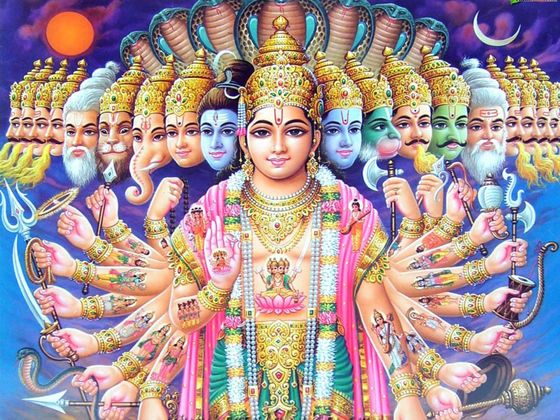Sanaatan Dharma teaches that the Lord manifests Himself from time to time. It is important that we as Hindus understand this concept and the types of incarnations. Hinduism says that there is God the known, God the unknown and God who is beyond the unknown. Our scriptures teach, “Maatri Devo Bhavah, Pitri Devo Bhavah, Acharya Devo Bhavah”: Mother, Father and Guru are your first Gods. These are the known Gods in our lives. God, the unknown, consists of the various forms of the Divine: Durga Maa, Lakshmi Maa, Saraswati Maa, Shivaji, Hanuman Baba, Ganesh Baba and so on. We know about these forms of the Divine Being yet we do not really know them.
God who is beyond the unknown is indefinable. It is the substratum of all existence, without differentiation. We refer to that state as Brahm, which exists in all forms of creation and is beyond creation. Our scriptures describe Brahm as “neti, neti”, that is, “neither this, nor that.” The Unmanifest Supreme Being is Nirguna Brahman, or God, the Absolute, Eternal One without attributes. However, this non-differentiated Being assumes a name and form and subjects Itself to the conditions of Brahma Prapanch, the world of created beings and objects. The Supreme Being is then referred to as Saguna Brahman, God with attributes. These nine conditions are:
- Space, time and causation
- Qualities (gunas) of sattva (purity, goodness), rajas (materialism, activity) and tamas (inertia, destruction)
- The main functions: creation, sustenance, destruction and re-absorption.
The three gunas, or primary qualities of nature, exist in the three planes of existence: bhu, bhuvah, swah, the earthly plane, the intermediate sphere and the heavenly sphere, respectively. In the heavenly sphere, there are Brahma, Vishnu and Shiva; they each symbolise one of the three gunas: Vishnu Bhagavan represents the infinite Brahm’s identification with the quality of sattva. Brahma is the unmanifest Brahm identifying with rajas. When Brahm identifies with tamas, there is Shiva. In the order of Being, tamas means the state of non-differentiation, Shiva. Sattva is lightness and pureness, Vishnu, while rajas is the power of creativity, Brahma, who creates the world. Brahma, Vishnu and Shiva are all personifications of Ek Brahm, the One Infinite. These are the first three manifestations that exist; they are called Guna Avataar. These avatars carry out the functions of creation, sustenance, destruction and re-absorption. Guna Avataar Shree Vishnu has unlimited forms and expressions.
There are four Vyuha Avataars, or transcendental manifestations of the Divine. According to the Ramaayan and the Bhagavat Mahaa Puraan, they are Shree Raam, Lakshman, Bharat and Shatrughan. In Dwaapar Yug, these four Avataars manifested as Shree Krishna, Balram, Pradumya and Anirudh. Bhagavat Maha Puraan says there are 23 Leela Avataars, and some schools of thought also include Buddha as a 24th Avataar. Most prominent among these are the ten major Avataars. The last Avataar, Kalki, is expected to appear at the end of Kal Yuga.
There are Ansha (partial) Avataar: According to the Ramaayan and Bhagavad Gita, the individual soul is part and parcel of the indestructible Supersoul. Each of us is a manifestation of the Divine. It is in this context that Sai Baba said, “I am Raam; I am Krishna. You are Raam; you are Krishna.” There is the profound saying, “Aham Brahmasmi”, “I am Brahm”, that we all must realise.
When Vyuha Avataar Shree Raam was born after King Dasharath completed the special yagya for getting children, half of the contents that emerged from the sacred fire was given to Queen Kaushalya, a quarter was given to Queen Kaikeyi and Sumitra received the rest in two parts. This is highly symbolic of Ek Brahma. When he manifests, there are two lakshans or qualities that he displays. One is called tatastha lakshan, that is, God behaves as a man in human form and one is called svarupa lakshan, where He behaves as a God, his true nature, in human form.
Each of us, as matter (the body) and spirit are tatastha lakshan. We act according to the world but svarupa lakshan, spirituality and divinity, is our essence. That divine intelligence has put us here for a reason and we should remember that we are sparks of the divine. Scriptures aid us on our journey to identify the ultimate objective of life, which is to realise “Aham Brahmasmi”.
Paramacharya of Swaha, Pt. Hardeo Persad (from a Sunday Morning service)



